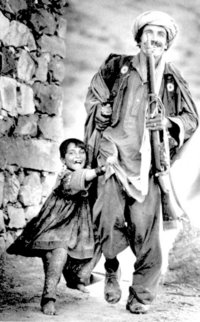
History :
Pashtoons can broadly be divided into five main branches i,e, Bhittannis, Chrugh Ashtees, Sarbanees, Kirlanis and Mattizees. Marwat presently living in the district of Lakki Marwat, belong to the Mattizai or Mattizee branch of Pashtuns. Marwat, descendants of Lohan, are also known as the Speen Lohani, (the White Lohani). They originally lived in Katawaz, Afghanistan. According to the present boundaries of the provinces, Katawaz lies in the province of Paktika in Afghanistan.
The Marwat migrated to Damans i.e. the present Tank District in KPK Province (formerly NWFP) Pakistan and settled down there, But the warrior tribe did not settle peacefully and took new feuds with their cousins- the Katti Khels and others. Marwats temporarily camped around the Pezu Pass, attacked Tank with full might and drove the Katti Khels out of it, who later, with the help of Gandapurs recaptured their area, repulsing Marwats through Baina Pass to Pezu. The Niazi, a cousin tribe of the Lohanis, lived in at present abode Lakki. Their abode was at the northern bank of Gambila River. The plains at the Right Bank of Gambila were used as their meadows. It was during the early reign of Akbar (1556-1605) when Marwats raided the Niazis with full force and eventually drove them towards their present abode Isa Khel (Tarna) District Mianwali, Punjab.
The Marwats practically remained independent during the Mughal, Persian and Afghan reigns. They provided as many as 200 mounted soldiers(Sawaras) for the Army of Ahmad Shah Durrani (1759) while he was on his way to Punjab via Bannu arming to invade India. The territory of Marwats came under the Kingdom of Afghanistan and was ruled by the Durrani kings for more than 70 years, but practically they remained independent.
In the beginning of the 19th century, Marwats fell in severe disunity and were engaged in internal feuds. Nawab Hafiz Ahmad Khan of Mankera Now in the district of Bhakkar, Punjab) took advantages and captured the area in 1819. He, however, had to abandon his hold of the area in favour of the Sikhs in 1823 after retaining it for more than four years. In 1836 Maharaja Ranjeet Singh formally annexed Marwats completely. Lt. Reynell Taylor captured the Marwat area, put an end with the Sikhs rule over the area and established British Rule on 11 January 1849. The Marwats arrived in this area, during the early years of the reign of King Akbar (1556-1605). In 1844, one Malik Fateh Khan Tiwana built and garrisoned a small fort in the heart of Marwat and induced by threat and promises many of the leading classes settled near it. He called his town Ihsan Pur later known as old Lakki. It continued to be the capital of Marwat till 1864.
Major Urmston, the then Deputy Commissioner, allowed its inhabitants to flit across to the right bank of the Gambila and settled amongst the sandy cluster of villages named Mina Khel, Khoidad Khel and Syed Khel (now Lakki city). Lakki Town then comprised of these three villages. At the annexation of Punjab in 1849, trans-Indus portion of Mianwali and Dera Ismail Khan were formed into a district with the headquarter at Bannu Lt. Reynell Taylor was appointed as the first Deputy Commissioner of the district. Derajat Division came into being on Ist January 1861, after breaking up of the district Layyah. . District Bannu, constituted the same year, was divided into two tehsils of Bannu and Lakki.
Lakki Marwat became sub-division in October 1950 and upgraded as an independent district in July 1992. Serai Naurang was given separate status of Tehsil in 2003.
(source: Distt Gazette of Distt Lakki Marwat by Bureaue of statistics, Islamabad)